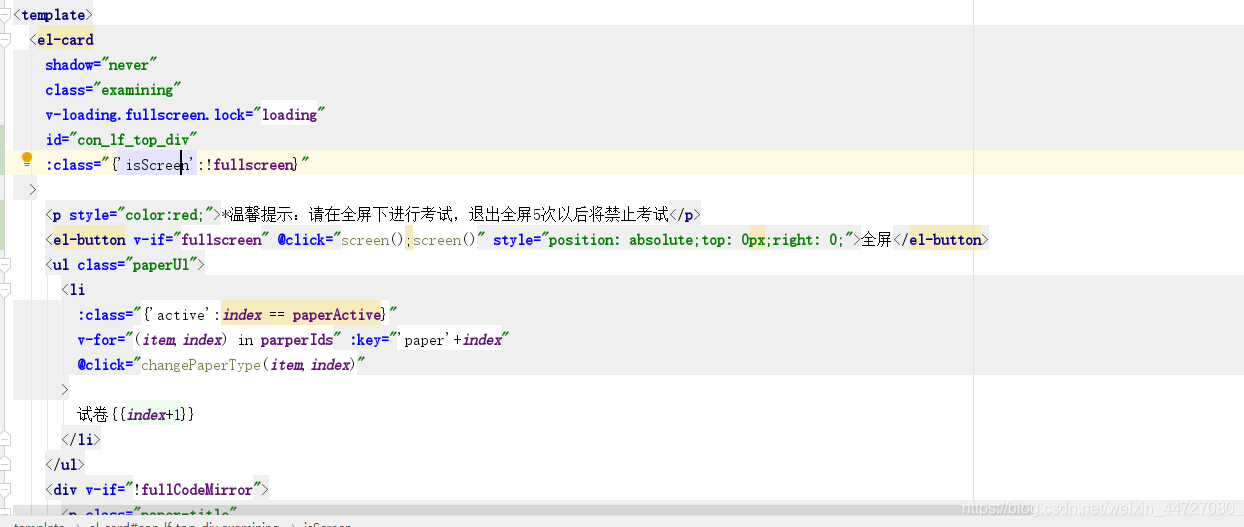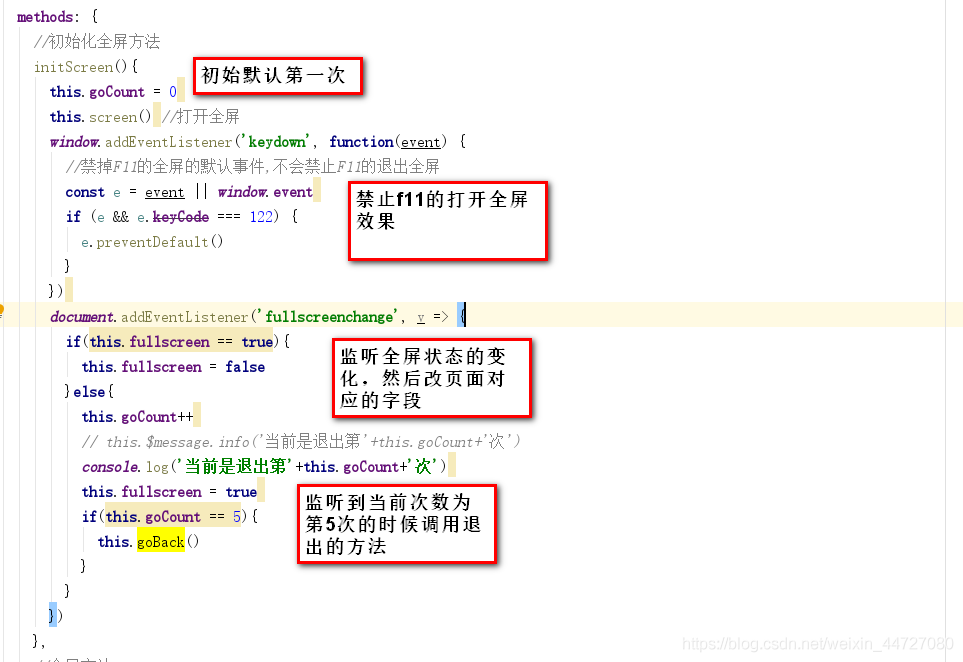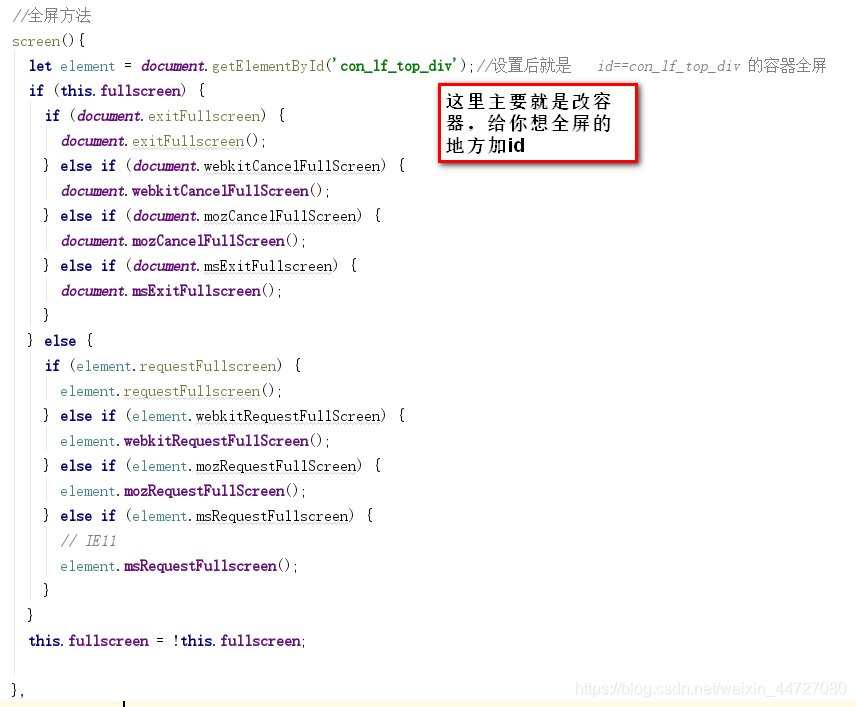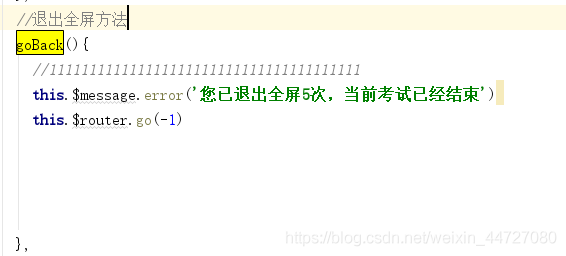vue中實現(xiàn)全屏以及對退出全屏的監(jiān)聽
vue中實現(xiàn)默認(rèn)進(jìn)來頁面,某個div全屏,并監(jiān)聽退出全屏的次數(shù),當(dāng)退出全屏次數(shù)達(dá)到5的時候跳轉(zhuǎn)到別的頁面。
實現(xiàn)步驟:1、頁面上在你想要的容器上加上id = ‘con_lf_top_div’,再給他加個動態(tài)class名,加上提示和點擊進(jìn)入全屏按鈕

<template> <el-card shadow='never' v-loading.fullscreen.lock='loading' : > <p style='color:red;'>*溫馨提示:請在全屏下進(jìn)行考試,退出全屏5次以后將禁止考試</p> <el-button v-if='fullscreen' @click='screen();screen()' style='position: absolute;top: 0px;right: 0;'>全屏</el-button> ...其他內(nèi)容
2、css部分,全屏后的部分需要單獨加樣式
.isScreen{ height:100vh!important; overflow-y: auto; }
3、js部分
data:
fullscreen:false,//是否全屏goCount:0 //退出第幾次
mounted初始化調(diào)用
mounted() { this.initScreen()}
methods定義方法:

//初始化全屏方法 initScreen(){this.goCount = 0this.screen() //打開全屏window.addEventListener(’keydown’, function(event) { //禁掉F11的全屏的默認(rèn)事件,不會禁止F11的退出全屏 const e = event || window.event if (e && e.keyCode === 122) { e.preventDefault() }})document.addEventListener(’fullscreenchange’, v => { if(this.fullscreen == true){ this.fullscreen = false }else{ this.goCount++ // this.$message.info(’當(dāng)前是退出第’+this.goCount+’次’) console.log(’當(dāng)前是退出第’+this.goCount+’次’) this.fullscreen = true if(this.goCount == 5){ this.goBack() } }}) },


1、頁面:<el-card : > <p style='color:red;'>*溫馨提示:請在全屏下進(jìn)行考試,退出全屏5次以后將禁止考試</p> <el-button v-if='fullscreen' @click='screen();screen()' style='position: absolute;top: 0px;right: 0;'>全屏</el-button> ... 2、data:fullscreen:false,//是否全屏goCount:0 //退出第幾次 3、mounted:this.initScreen() 4、methods: //初始化全屏方法initScreen(){ this.goCount = 0 this.screen() //打開全屏 window.addEventListener(’keydown’, function(event) { //禁掉F11的全屏的默認(rèn)事件,不會禁止F11的退出全屏 const e = event || window.event if (e && e.keyCode === 122) { e.preventDefault() } }) document.addEventListener(’fullscreenchange’, v => { if(this.fullscreen == true){ this.fullscreen = false }else{ this.goCount++ // 注意這里的事件都會觸發(fā)兩次 console.log(’當(dāng)前是退出第’+this.goCount+’次’) this.fullscreen = true if(this.goCount == 5){ this.goBack() } } })},//全屏方法screen(){ //設(shè)置后就是id==con_lf_top_div 的容器全屏 let element = document.getElementById(’con_lf_top_div’); if (this.fullscreen) { if (document.exitFullscreen) {document.exitFullscreen(); } else if (document.webkitCancelFullScreen) {document.webkitCancelFullScreen(); } else if (document.mozCancelFullScreen) {document.mozCancelFullScreen(); } else if (document.msExitFullscreen) {document.msExitFullscreen(); } } else { if (element.requestFullscreen) {element.requestFullscreen(); } else if (element.webkitRequestFullScreen) {element.webkitRequestFullScreen(); } else if (element.mozRequestFullScreen) {element.mozRequestFullScreen(); } else if (element.msRequestFullscreen) {// IE11element.msRequestFullscreen(); } } this.fullscreen = !this.fullscreen; },//退出全屏方法goBack(){ //111111111111111111111111111111111111111 this.$message.error(’您已退出全屏5次,當(dāng)前考試已經(jīng)結(jié)束’) this.$router.go(-1)},更多資料:
https://blog.csdn.net/qq_41619796/article/details/104751814
https://blog.csdn.net/wangsiyisiyi/article/details/117086453
到此這篇關(guān)于vue中實現(xiàn)全屏以及對退出全屏的監(jiān)聽的文章就介紹到這了,更多相關(guān)vue中實現(xiàn)全屏以及對退出全屏的監(jiān)聽內(nèi)容請搜索好吧啦網(wǎng)以前的文章或繼續(xù)瀏覽下面的相關(guān)文章希望大家以后多多支持好吧啦網(wǎng)!
相關(guān)文章:
1. 如何用python開發(fā)Zeroc Ice應(yīng)用2. ASP錯誤捕獲的幾種常規(guī)處理方式3. python用pyecharts實現(xiàn)地圖數(shù)據(jù)可視化4. python基于opencv批量生成驗證碼的示例5. python軟件測試Jmeter性能測試JDBC Request(結(jié)合數(shù)據(jù)庫)的使用詳解6. npm下載慢或下載失敗問題解決的三種方法7. ASP編碼必備的8條原則8. Python查找算法之折半查找算法的實現(xiàn)9. python numpy.power()數(shù)組元素求n次方案例10. 使用Spry輕松將XML數(shù)據(jù)顯示到HTML頁的方法

 網(wǎng)公網(wǎng)安備
網(wǎng)公網(wǎng)安備